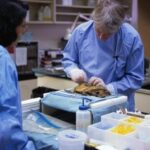Can a medical laboratory specialist, steeped in the minutiae of cellular analysis and biochemical assays, truly ascend to the hallowed halls of pathology? The query, seemingly straightforward, unveils a labyrinthine pathway fraught with stringent academic prerequisites and intensive experiential learning. It’s a journey not unlike transforming a skilled cartographer into a seasoned explorer, demanding both innate aptitude and relentless dedication. Is such a metamorphosis feasible? Let’s delve into the complexities.
The Foundational Disparity: Scope of Practice
The initial hurdle lies in the divergent scopes of practice. A medical laboratory specialist, often denoted as a medical laboratory scientist (MLS) or medical technologist (MT), operates primarily within the diagnostic realm. These professionals are the unsung heroes of healthcare, meticulously performing and analyzing a vast array of laboratory tests. Their expertise centers on the technical aspects of laboratory medicine, ensuring accuracy, precision, and timely reporting of results. They identify microorganisms, analyze blood samples, and perform complex immunoassays. Their skill set is incredibly valuable.
Pathologists, on the other hand, assume a more encompassing role. While they undoubtedly possess a deep understanding of laboratory methodologies, their primary function revolves around the interpretation of these results in the context of disease. Pathologists render diagnoses, assess disease staging, and provide crucial insights for treatment planning. Their purview extends beyond the technical, encompassing clinical correlation, morphological evaluation, and often, direct patient interaction. Consider the intricate dance of interpreting a bone marrow biopsy – the pathologist must weave together the cellular morphology, immunohistochemical staining patterns, and clinical history to arrive at a definitive diagnosis. This requires a level of medical knowledge and clinical judgment not typically within the purview of an MLS.
The Academic Gauntlet: Medical School and Residency
The fundamental prerequisite for becoming a pathologist is, unequivocally, a medical degree (MD or DO). This necessitates completing a rigorous four-year medical school curriculum, encompassing basic sciences (anatomy, physiology, biochemistry, pharmacology) and clinical rotations across various medical specialties. For an MLS seeking this transition, this represents a significant commitment of time and resources. It involves not just mastering new scientific principles but also developing clinical acumen and patient management skills. Moreover, securing admission to medical school is itself a competitive endeavor, requiring stellar academic performance and compelling personal attributes.
Following medical school, the aspiring pathologist must then embark on a residency program in pathology, typically lasting four years. During this period, residents receive intensive training in all aspects of pathology, including anatomic pathology (surgical pathology, cytopathology, autopsy pathology) and clinical pathology (blood banking, microbiology, chemistry, hematology). They learn to interpret histopathological slides, perform fine needle aspirations, manage blood transfusions, and oversee the operations of a clinical laboratory. The residency experience is a crucible, forging the raw medical graduate into a competent and confident pathologist. This is a demanding process.
The Experiential Bridge: Opportunities for Advancement and Specialization
While the path from MLS to pathologist is not direct, there are avenues for MLS professionals to enhance their knowledge and skills, potentially facilitating a smoother transition. Some universities offer bridge programs or accelerated curricula for individuals with prior science backgrounds, including MLS professionals. These programs may grant advanced standing or allow for the transfer of credits, shortening the overall duration of medical school. A more direct path is further educational attainment and leadership opportunities. Advanced certifications and supervisory roles within the laboratory can provide valuable experience and insight into the diagnostic process.
Furthermore, specialized training in areas such as molecular diagnostics or cytogenetics can deepen an MLS’s understanding of disease mechanisms and diagnostic techniques, making them a more competitive candidate for medical school or pathology residency. Some MLS professionals may even pursue a Ph.D. in a related field, such as immunology or microbiology, which can open doors to research opportunities and academic positions.
The Articulation of Skills: Leveraging Existing Expertise
It is crucial to acknowledge that the skills acquired as an MLS are not rendered obsolete upon entering medical school or residency. On the contrary, the deep understanding of laboratory methodologies, quality control procedures, and data analysis provides a solid foundation for further learning. The MLS’s meticulous attention to detail, problem-solving abilities, and commitment to accuracy are highly valuable assets in the practice of pathology. The transition, therefore, is not a complete reinvention but rather a building upon existing expertise.
A Calculated Leap: Weighing the Rewards and Challenges
Ultimately, the decision to pursue a career as a pathologist rests on individual aspirations and circumstances. The path is undeniably challenging, requiring significant investment of time, effort, and financial resources. However, the rewards of practicing pathology – the intellectual stimulation, the opportunity to make a meaningful impact on patient care, and the prestige of the profession – are substantial. Aspiring pathologists must carefully weigh these factors before embarking on this transformative journey. This isn’t a decision to be taken lightly.
In conclusion, while a medical laboratory specialist cannot directly become a pathologist without the requisite medical degree and residency training, their prior experience can be a valuable asset. With dedication, strategic planning, and a willingness to embrace the challenges ahead, the transition, though arduous, is indeed possible.










Leave a Comment